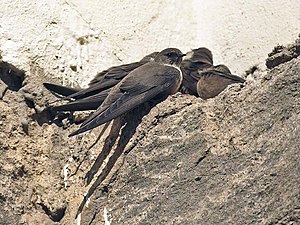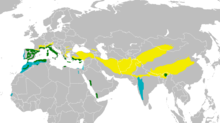Rock tern
| Rock tern | ||||||||||||
|---|---|---|---|---|---|---|---|---|---|---|---|---|

Rock tern ( Ptyonoprogne rupestris ) |
||||||||||||
| Systematics | ||||||||||||
|
||||||||||||
| Scientific name | ||||||||||||
| Ptyonoprogne rupestris | ||||||||||||
| ( Scopoli , 1769) |
The Crag Martin ( Ptyonoprogne rupestris ) is the Uferschwalbe quite similar, but with a height of 14-15 cm slightly larger. This swallow almost always hangs near rock faces and rarely high in the air.
description
The top and bottom are brownish. There are white spots on the control feathers, which can only be seen in flight when the tail is spread. There is no chest strap. The wingspan is approx. 26 cm. The rock tern's voice is soft and rarely heard. The singing is hasty, chirping harshly. She calls hard “prrit” or “pritprit”.
habitat
The rock tern lives in southern Europe in rock faces, gorges, bridges and tunnels by the water. In North Tyrol, the rock tern is increasingly populating buildings such as hotels, private houses, farmhouses and barns. The preferred nest location is the house's ridge purlin. Thus the rock tern, like the barn swallow and house martin, is increasingly becoming a cultural follower. Many of the rock faces in North Tyrol, which used to be known as breeding grounds, have already been abandoned. Similar tendencies are known from Switzerland and South Tyrol.
Reproduction
The breeding sites are located on dry and often sunlit rock faces, protected from the wind. In the northern and eastern Alps, the breeding walls are mostly low above a wide valley, in the west and in the southern Alps they are also high above the valley floor. Walls exposed to the north and west are usually avoided. Small colonies of two to five breeding pairs are typical in the Alpine region. Breeding sites with more than 15 breeding pairs are exceptions.
The breeding season is between May and July. Rock terns sometimes arrive at their breeding grounds at the end of February. In climatically favorable years, there are 2 annual broods. Then the breeding business can drag on until the beginning of October. The nest is a shell made of clay and saliva under overhanging rock, on houses preferably on the ridge purlin or under a roof overhang, also close to busy streets. While the nest is still being hatched, repairs and additions are made. In contrast to the house martin, the nest is open at the top, similar to that of the barn swallow. The clutch consists of two to five eggs. The laying interval is one day. The eggs are elongated elliptical. They are white with a few red and gray spots mostly concentrated on the blunt end. The incubation period is fourteen to fifteen days. It is predominantly the female parent bird that breeds that is not fed by the male. The nestling period is 24 to 28 days. The young are fed for a further 14 days after they leave.
food
Flying insects that get lost in the limited air space of the rock swallow by the wind are caught in flight.
Inventory development in Central Europe
The rock tern was a locally widespread breeding bird in the central Alpine areas and foothills in the south of Central Europe until the 1960s. It was rare in the north of the Alps, and had been absent in the canton of Jura since the 19th century. Since the 1980s there has been an increase in population in the north and east of the Alps, in some cases considerable. In this context, climatically favorable years may play a role both in the Alpine region and in the wintering areas in the Mediterranean region. The population increase has in part led to a considerable expansion of the area in the foothills of the Alps. Rock terns have been breeding again in the canton of Jura since 1980. A strong increase and tendency to spread is also noticeable for Styria, western Switzerland and southern Bavaria. The northernmost breeding areas in Central Europe are currently in the Black Forest. In 2018, 17 pairs of rock tern breeds in Baden-Württemberg. In Baden-Württemberg, the rock tern also breeds on structures such as the Ravennabrücke .
supporting documents
literature
- Hans-Günther Bauer, Einhard Bezzel , Wolfgang Fiedler (eds.): The compendium of birds in Central Europe: Everything about biology, endangerment and protection. Volume 2: Passeriformes - passerine birds. Aula-Verlag Wiebelsheim, Wiesbaden 2005, ISBN 3-89104-648-0 .
- Detlef Singer: What is flying there? Franckh-Kosmos, Stuttgart 2011, ISBN 978-3-440-12532-8 .
Single receipts
- ↑ D. Singer, p. 42.
- ↑ Bauer et al., P. 151 and p. 152.
- ↑ Bauer et al., P. 152.
- ↑ Bauer et al., P. 151.
- ^ Bettina Maier: The rock tern Ptyonoprogne rupestris in Baden-Württemberg. Working Group Wanderfalkenschtz Annual Report 2018: 14-15.
- ↑ Bettina Maier: Population development of the rock tern Ptyonoprogne rupestris in southern Baden-Württemberg (Germany) in 2017 . The Bird World 138: 123-140.
Web links
- Videos, photos and sound recordings of Ptyonoprogne rupestris in the Internet Bird Collection
- Entry at the Swiss Ornithological Institute
- Age and gender characteristics (PDF; 2.8 MB) by Javier Blasco-Zumeta and Gerd-Michael Heinze (English)
- Ptyonoprogne rupestris in the Red List of Threatened Species of the IUCN 2013.2. Listed by: BirdLife International, 2012. Retrieved November 23, 2013.
- Feathers of the rock tern


